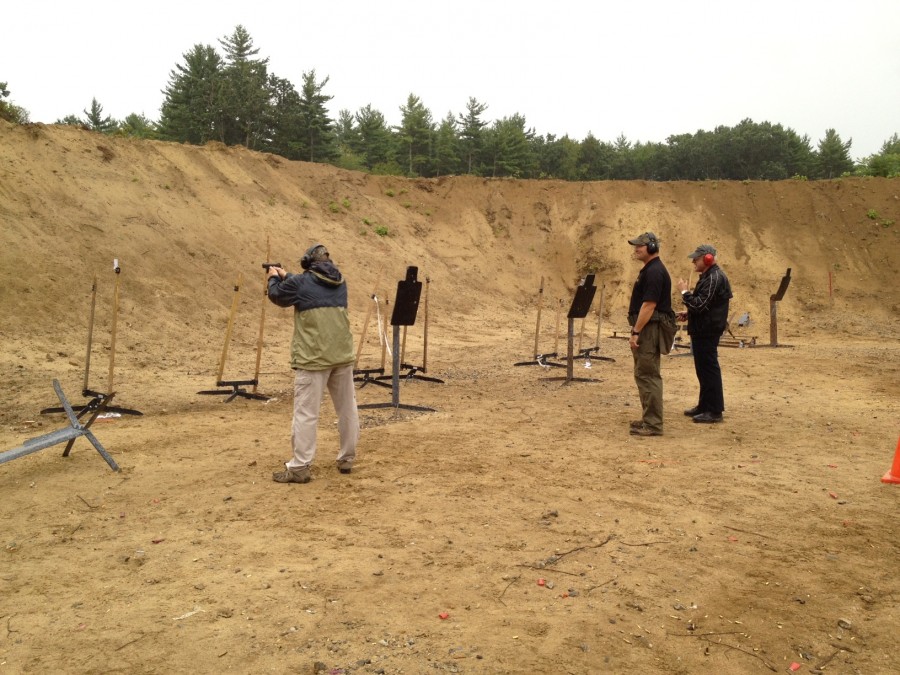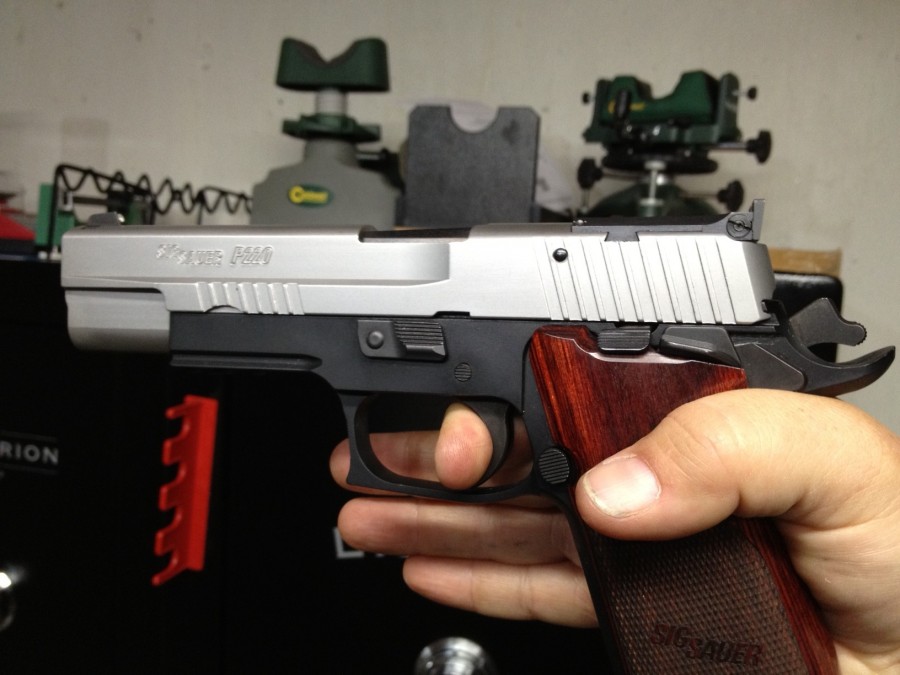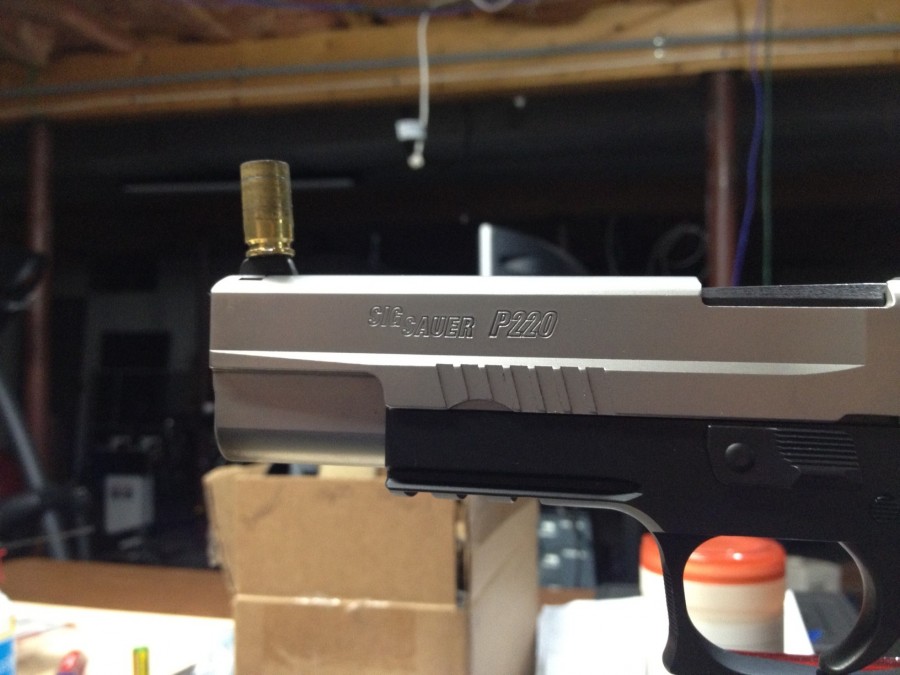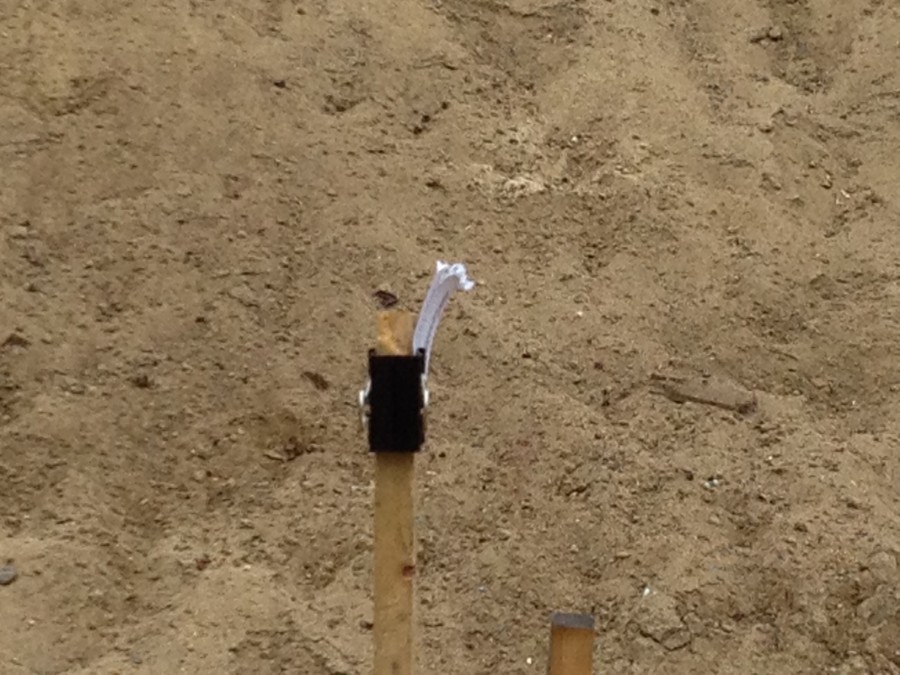 How far do you feel comfortable shooting your pistol? Three yards? Seven? Twenty-five? What if I told you that it’s very possible to accurately shoot most standard caliber pistols out to ranges as far as 100 yards? Think I’m nuts? Think I’ve sniffed a bit too much gun powder today? I won’t dispute either of the preceding allegations, but I will tell you that you can consistently hit a chest-sized steel plate at distances of 100 yards or more using your standard pistol. To be honest, I didn’t think it was possible myself, but then I decided to give the SIG Sauer Academy’s half day Long Range Pistol Shooting Class a try . . .
How far do you feel comfortable shooting your pistol? Three yards? Seven? Twenty-five? What if I told you that it’s very possible to accurately shoot most standard caliber pistols out to ranges as far as 100 yards? Think I’m nuts? Think I’ve sniffed a bit too much gun powder today? I won’t dispute either of the preceding allegations, but I will tell you that you can consistently hit a chest-sized steel plate at distances of 100 yards or more using your standard pistol. To be honest, I didn’t think it was possible myself, but then I decided to give the SIG Sauer Academy’s half day Long Range Pistol Shooting Class a try . . .
The four hour classes that the SIG Academy offers are some of the most valuable hidden gems in their curriculum. You don’t spend any time in the classroom. Instead, you hit the range almost immediately and spend four solid hours improving one particular skill set.
The Academy doesn’t offer many four hour courses, but the ones they do offer are perfect for working on a specific skill. And with class prices of only $100 (or even less if you have the 20% prior student discount), they aren’t a huge strain on the wallet.
The three half day classes that I have taken (Long Range Pistol Shooting, Close Quarters Pistol Techniques, and Point vs. Precision) were lightly attended with fewer than a half dozen students in each one. That means the four hours are chock full of good student-instructor interaction for everyone who does attend.
We spent the first hour or so reviewing the fundamentals of shooting (oh God, you’re probably groaning, “not more fundamentals,” right?). But when you think about it, reviewing fundamentals in a class where you are going to be shooting very long distances makes a lot of sense. As you probably know, technique errors that result in slight inch or two deviations from the bull’s-eye at 5 yards quickly grow into large, whole target missing deviations the further back you go.
We started with variations of the standard SIG bullet hole drill at 7 yards. This is a phenomenal drill that anyone can practice any time. You simply draw and fire your first shot wherever you like. The trick is to put the next four shots through the same hole as the first. I can assure you it’s not as easy as it sounds. The bullet hole drill has been a part of every single class I have taken and I have yet to see even the most senior instructors successfully nail all five shots through the exact same hole.
It takes a solid stance and solid pistol grip along with a perfect trigger squeeze and no unconscious dropping of the barrel to peek at where your shot went. If you don’t see the muzzle flash, you aren’t doing it right.
One benefit of the drill is the pattern your shots make at this range can diagnose problems that are easily corrected. If your shots form a vertical line, chances are that you may be dropping the barrel of the gun slightly as you take your shot. Deviations left or right indicate that your grip may not be what you need it to be. The reach to the trigger might be too long for your hand, your trigger press isn’t as smooth as you thought or the three fingers gripping the gun are squeezing slightly in a sympathetic motion when you press your trigger.
Next we ran a drill designed to test the sympathetic motion theory. The idea is to hold the gun with your strong hand only, gripping it with your thumb and back of the hand alone.
 You stick your lower three fingers straight out, then pull the trigger. You can run do this dry or with ammo. The object is to practice squeezing the trigger with your index finger while keeping your lower three fingers from sympathetically curling up at the same time. If you can train your hand not to move the lower three fingers, this will avoid the fingers moving when you hold the gun normally, thus eliminating one reason for your shot to go off line.
You stick your lower three fingers straight out, then pull the trigger. You can run do this dry or with ammo. The object is to practice squeezing the trigger with your index finger while keeping your lower three fingers from sympathetically curling up at the same time. If you can train your hand not to move the lower three fingers, this will avoid the fingers moving when you hold the gun normally, thus eliminating one reason for your shot to go off line.
It’s a good one-handed drill to practice with both hands so that you train yourself to shoot accurately with either hand. Ideally, you want to practice with a double action pistol or revolver that has a fairly heavy trigger. If you can manage to keep the fingers steady with a heavy pull, it will be a walk in the park to do it with a lighter single action pull.
A third drill we practiced requires a partner, but this one is intended to be done without ammo, so you can safely practice this one at home to your heart’s content. For one you grip the gun normally with two hands and have your partner balance an empty shell casing on the front sight.
 The object of the game is to squeeze the trigger and release the hammer without the shell casing falling off of the gun. As you can imagine, it doesn’t take much movement in any direction to knock the shell casing off, so it really helps you practice the fundamentals of a steady hold.
The object of the game is to squeeze the trigger and release the hammer without the shell casing falling off of the gun. As you can imagine, it doesn’t take much movement in any direction to knock the shell casing off, so it really helps you practice the fundamentals of a steady hold.
This drill obviously has to be done dry as there is no way the shell casing is going to stay on if the gun goes bang. Make sure to run it in double action as only the people with the steadiest grip will be able to successfully execute the trigger pull with something like a 10 pound double action weight and keep the shell casing on top. Try to do it five times in a row and then switch with your partner.
With the close up drills behind us, we moved on to shooting as distance. We started at the 10 yard line and then moved back to the 25, 35, 50, 75, and finally the 100 yard line. The 100 yard training is a component of the Department of Homeland Security’s standard repertoire. DHS agents aren’t required to qualify at 100 yards, but they practice at this distance because once you get comfortable hitting a steel plate that far out, hitting one at 25 yards is child’s play.
Ballistics of the round you use will affect what sort of hold over you need as you move further out. Both 9mm and .357 SIG cartridges have very flat trajectories, so point of aim is generally point of impact whether you are at 10 or 100 yards. But .40 and .45 start to drop a bit at those distances, so you’ll need to compensate.
One word of warning: be careful shooting long distance on ranges with low berms. If you screw up and accidentally drop the muzzle when firing, there is a distinct possibility that the round could impact the dirt before the target and ricochet up and over the berm. So you’ll probably want to warm up, incrementally increasing your distance rather than just starting at the 100 yard line.
Your pistol’s sights are definitely going to play a role here. As we got back beyond the 25 yard line, point of aim came into play, but not in the way you might intuitively think. I found that as I started to move back, my shots started going over the top of the chest plate even though I was holding my sights dead center.
Our instructor pointed out that most combat gun sights are optimized for 25 yards. Move much further back from that point and you actually need to start holding low in order to hit the target. Once I moved my sights to the standard pumpkin on a post hold, my rounds started to hit the chest plate dead center.
After we had gained some proficiency with the various distances, the instructor added another element to the game – time. One at a time, we had to draw and fire until we successfully hit the plate at each of the distances. The student with the lowest overall time won. The addition of the time factor definitely fouled all of us up a bit and at each distance a different student won the race.
With some amount of pride, I can tell you I managed to win the 75 and 100 yard shots, successfully hitting the plate from a draw in two shots and under 9 seconds at 100 yards. I was also the only student who wasn’t a LEO, so take that for what it’s worth.
Our instructor had one final challenge for us. He placed business cards, edge facing us and had us stand 3 yards back. The object was to draw and fire. The first student who could successfully split the business card in half won. Again, I surprised everyone including myself by drawing my pistol and splitting the card on my first shot.
 A fair question is whether or not this kind of long range shooting is really necessary. Conventional wisdom says the purpose of a pistol is for short range shooting and anything outside of 25 yards or so is best attempted with a rifle or carbine. Unfortunately, there are plenty of occasions where a pistol is all you are going to have since people in most places I go tend to react somewhat negatively if I strolled around with a rifle slung over my shoulder.
A fair question is whether or not this kind of long range shooting is really necessary. Conventional wisdom says the purpose of a pistol is for short range shooting and anything outside of 25 yards or so is best attempted with a rifle or carbine. Unfortunately, there are plenty of occasions where a pistol is all you are going to have since people in most places I go tend to react somewhat negatively if I strolled around with a rifle slung over my shoulder.
I also thought back to my Civilian Response to Terrorist Threats class and remembered one of the final tests. In that scenario, we were told that we were in a shopping mall and there was a “terrorist” wearing a suicide vest about 40 yards away. We had one chance to hit the “terrorist” and knew that impacting his body would likely detonate the vest. Our only option was a clean head shot. So if you’re comfortable shooting at 100 yards you’ll find that a lot easier than someone who’s only practiced out to 25 yards.
In the end, shooting out to 100 yards is a great and challenging skill to master and the SIG Academy’s Long Range pistol shooting class is a great place to develop it.




“Make sure to run it in single action as only the people with the steadiest grip will be able to successfully execute the trigger pull with something like a 10 pound double action weight and keep the shell casing on top. Try to do it five times in a row and then switch with your partner.”
I must protest this. When I owned DA/SA semi-autos I would run the ‘Casing drill’ in double action. Part of the reason I don’t own those guns anymore is because I discovered all my DA/SA guns required different holds and trigger finger placement to smoothly work the DA trigger without dropping the casing. The 5906 required a different hold then a Sig 2022, which both were different than the hold and trigger finger placement on my Beretta.
Now I shoot 1911s , and the casing stays put on my front sight without fail now.Hehe.
You are absolutely right. Brain fart here. Meant to say double action, not single action. Fixed the original post.
except for shits and giggles i can’t imagine having to shoot at 100 yards with my handguns. still, next time i go to the rifle range i’ll try my m10 at the 50 yard line and see what results i get.
There will never be a Charter Arma 100-yard shooting class. Unless the target is a Winnebago or a shipping container.
Almost any shot is possible on a flat range with plenty of time and ammo and with no adrenaline dump and no rounds zipping past your head.
I can make 100 yard pistol shots every now and then. But I dont practice them. Because at 100 yards, realistically, i’m either not going to shoot, out of liability, or i’m going to take that shot with a long gun.
Back in the day, our semi-annual qualification included the 50 yard line. While that’s old news, we do demos for the recruits out to 100 just to show them it can be done.
Agreed.
And I’ll add NRA Bullseye. Granted, not quite 100 yds either, but a timed or rapid fire drill at 25 yds one handed will set you up for success in all sorts of other disciplines. 50 yds one handed also requires learning the same kind of control (though a nice S&W Mod 52 sure helps!)
Hickok45 seems to enjoy showing tiny guns reaching out to his 80 yard gong.
Interesting stuff. Thanks for the tips on the exercises. Sound like good things for someone just starting out like me to get working on ASAP to avoid bad habits.
I have shot 100 yards with a Ruger Sp101 inch barrel, just to see if I could hit the target. Granted the target was 24 inches. This was mostly to see if I could.
I had a chance to visit a client’s personal shooting range once, and got to shoot a steel target halfway up the side of a hill at 250 yards with a .22 rifle, which was pretty cool. Then there was that quick draw artist who could hit steel at 350 yds with his Peacemaker, which was truly impressive. (Can’t remember his name–carried the moniker of world’s fastest draw, and there are utubes of him proving it.) I’ll have to try this sometime; sounds like fun.
mark n. on some of the old school ranges we had running deer targets. motorised targets on tracks that crossed from one side to the next. the longest shot on 1 of those i took was at 250 yards. that was fun.
Quick draw artist sounds like Bob Munden, an AMAZING guy to watch shoot!
There may not be many practical reasons to shoot at 100 yards with your handgun but one thing is for sure–if you can hit at long range, it makes short range shooting that much easier.
A friend and I were shooting off a bridge when a sheriff’s deputy pulled up, presumably because someone had called and complained. He asked what we were shooting at and we pointed to stumps sticking out of the water, some 100 to 300+ yards distant. He said, “Are you kidding? We never shoot any further than 25 yards!” He was carrying a Glock 9mm and not only did he not run us off the bridge, he joined in the fun. In no time, he was hitting the 100 yard stumps which looked to be 8″ diameter with about 12″ sticking out of the water.
We also used to shoot at a 55 gallon barrel, diagonally across a 28 acre field. That works out to about 520 yards if the field was square; a pretty long shot for a pistol. We hit it with everything we had, including my .45 auto. It’s not that hard to do, all you have to do is try. FWIW, some bullets went completely through that barrel.
I was eaten by a dinosaur once. I’m all better now, though.
I was at the range this weekend shooting my G20 and Ruger Blackhawk 45 Colt at 25 and 50yds. Best group with the G20 @50yds was not great (stock trigger)….basically was able to hit paper but not much better.
My best 5-shot group with the Blackhawk was impressive (to me). About 4in at 50yds. (we wont talk about my worst group at that distance).
Long range shooting with pistols is fun. Practical?…maybe. Fun, yes.
I find that hitting at 100yds is a challenge because my sights tend to block out the entire target frame. Its a guessing game mostly. You have to use other reference points to bracket the sights. But it can be done.
Now, if I put a red-dot on there and had a good rest…that would be fun.
When I entered the FBI Academy at Quantico, VA, in the late 70’s, I and other new agents were given S&W model 10 revolvers with a 2.5″ barrels. Our main qualification course, the Tactical Revolver Course (TRC), consisted of 60 shots; 18 from 50 yds., 18 from 25 yds., 12 from 15 yds. and 12 from 7 yds. When I was initially told that we were expected to shoot a 2.5″ .38 revolver at 50 yds. and hit the target, I thought my short-lived FBI career was going to end before it had actually begun. I was literally amazed how accurate that revolver was and how relatively easy it was to hit a silhouette target at 50 yds. with proper training. At the 50 yd. position, 6 rounds were shot prone and 12 standing; 6 weak hand and 6 strong hand. I sways scored in the high 90’s which meant only 2 or 3 shots were outside the silhouette. I almost never missed from the 50yd. line. For some reason, I missed from 25 or 15 yds. Since the course was timed, I think it was the stress of having to finish within a certain time limit.
The bottom line and moral of this long-winded story is that with practice, anything can be done, including shooting and hitting a target at 50 or even 100 yds.
Back when Blue Trail Range in Wallingford CT still had it’s 200 yard range open, there was a torso sized piece of boiler plate hung out at 150 yards. Using my friend Eric’s 1950’s vintage Colt 1911, I discovered that, fired from prone with about one third of the front sight above the rear, I could manage head sized groups in the plate’s center of mass.
I believe Eric was loading a 225 grain Lyman cast very hard over a hot load of Unique, so the ballistics should be essentially the same as 230 grain ball.
‘Both 9mm and .357 SIG cartridges have very flat trajectories, so point of aim is generally point of impact whether you are at 10 or 100 yards.”
Really? That’s impressive…
Comments are closed.